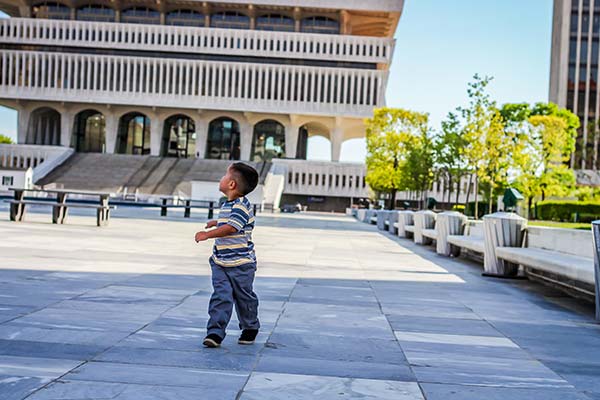Subtotal: $
Checkout
We tend to think of cities as belonging to a certain kind of person: the young adult, unattached and highly mobile. Cities, after all, are the economic engines of any country. But from a child’s viewpoint, life in a city offers different kinds of possibility – and of wonder.
As an eight-year-old visiting Fort Worth, twin city of my home of Dallas, I believed cities were meant for us kids. Sure, I realized that adults ran everything in Fort Worth, from its old trains and stockyards to its many companies. But downtown was my personal Emerald City, at once more magical and more terrible than the sleepy Dallas suburb I called home.
For children, cities open a window into the highs and lows of human existence. It was in Dallas that I saw my first grand cathedral and in Fort Worth that I had my first encounter with homelessness. Although my memories have become fuzzy, those experiences were formative.
Today, even in cities considered child-friendly – thanks to their relative safety, quality of schools, and cost of living – children are usually confined to cars and thus robbed of full participation in urban life. My friend Nicola, mother of three, shares my sentiments. Her family recently returned to Arlington, VA. “There’s so much richness you gain from walking through the world, especially as a child,” she says. “It gives children so much more engagement with life around them.”

Experiencing the world on foot shouldn’t be a perk off-limits to people under a certain age. Walking through any environment, we learn about and interact with it. Ultimately, children will take ownership of these spaces. And, as Nicola points out, “Kids are people, too. They deserve to visit interesting places, do interesting things, and eat interesting food. There’s a sense that children should only do ‘kid’ things; but for them, being allowed to follow their interests instead of offering them a highly curated schedule is liberating.” (Sidewalk Tetris is underrated as free entertainment for a restless child.)
As children acquaint themselves with a city, they realize there is a ready-made education far from the classroom. Some of this education comes through deliberately sought-out events – story time at the library, for example, or scheduled play dates. But daily routines are almost more important: using public transportation, finding references to the city’s past, and learning to move alongside other people in every stage of life and from every imaginable background.
I recently took a new friend’s four-year-old daughter to Washington’s National Building Museum, which supports children in constructing their own architectural masterpieces. This shared adventure was a delight both because of our fascinating destination and because of everything we saw. All the way from my apartment to the museum, my little charge was commenting on which Metro stops were busier than others, exchanging grins and giggles with other kids, and marveling at the buildings we passed.
For so many reasons, our city might be wonderland for children. From the storied Smithsonian to the myriad parks with their activities, there is little within the District that a determined child could not explore on foot. The entire city becomes a never-ending civics lesson, an institutional quilt of our country’s best and worst moments, its landscape punctuated by monuments to the men and women who built our country. The availability of public transit makes D.C. unique among American cities, and small children ride free.
Except every year there seem to be fewer of them enjoying these benefits.
“The key to living with children in a city,” Nicola says, “is figuring out what’s appealing in that city and finding ways to take advantage of it. For us, the big thing is interacting with friends in a casual setting.” Nicola and her husband host a Monday night potluck at their home, with a rotating cast of characters. For over a year, I’ve watched their children grow and change in remarkable ways. Nicola says of their transformation, “It’s cool to watch our kids develop personal connections that we aren’t directly mediating.”
Holding space for children in cities is important for the rest of us, too. Hearing their laughter as they play in the streets – or even their crying during our commutes – reminds us that life isn’t just what happens between twenty and forty, and that we live and work not only for ourselves but for the people who will follow us.
Cities, in return, let children dream about what kind of world they’d like to create, and give them opportunity to do so as they grow.

Sign up for the Plough Weekly email

Tamara Winter is the Communications Lead of the Charter Cities Institute. Follow her on Twitter: @_TamaraWinter
Already a subscriber? Sign in
Try 3 months of unlimited access. Start your FREE TRIAL today. Cancel anytime.






Lawrence
Nice article, but sorry, I believe the economic engines of a nation are the farmers who make it possible for the money people to exist. Best regards - Lawrence